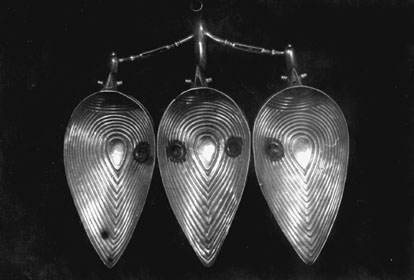

 | Page 230 |  |
developed. The great number of early–Bronze Age tumuli allowed a certain analysis of the Pit-Grave culture to be made (Panayotov 1989), and important late–Bronze Age flat and tumular necropolises were excavated near Orsoja, Nova Zagora, and Borino. Moreover, both historical and epigraphic (Linear B texts) records and the archaeological data show that during the late Bronze Age, the present Bulgarian lands were already inhabited by Thracian tribes. Special studies pay attention to Bronze Age chronology, periods, and culture (Bailey and Panayotov 1995; Bonev 1988; Katinčarov 1975; Leshtakov 1997; Nikolova 1999; Panayotov 1988; Stefanovich, Todorova, and Hauptmann 1998), and also the bronze metalwork (Chernych 1978). One of the most important finds from the late Bronze Age is the Vulchitrun treasure, a ritual set of thirteen gold items 12.425 kilograms in weight (Ancient Gold 1998; Venedikov 1987).

Gold libation vessel from the Vulchitrun treasure, Late Bronze Age
(Courtesy of Nilola Theodossiev)
Study of the Iron Age (divided in two periods: early, 1050 or 1000–550 or 450 b.c., and late, 550 or 450 b.c.–late first century b.c. or early first century a.d.) has produced most important results concerning the cultural and historical development of ancient Thrace (part of modern Bulgaria). Some fortresses, open settlements, and sanctuaries from the early Iron Age have been investigated, and the mortuary practices show significant diversity: both flat graves and tumuli with inhumation and cremation burials were used while numerous rock-cut tombs and megalithic dolmens were built in southeastern Thrace. The introduction of iron metallurgy caused social and economic changes, and bronze was used mainly in the production of jewelry and cult figurines. Several rich finds like the Barzitsa treasure and the Kazichene hoard reflected the economic advance of the Thracian aristocracy.
Some general studies and articles on the early Iron Age have been published (Archibald 1998; Bailey and Panayotov 1995; Gergova 1987; Stefanovich, Todorova, and Hauptmann 1998; Stoyanov 1997; Tončeva 1980). From the sixth century b.c. onward, interrelations among Thrace, ancient Greece, and Anatolia intensified,
 |  |